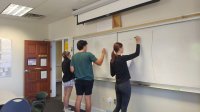A Collaborative Approach to Mistake Analysis
This method calls for students working in groups to create problems, point out common errors, find solutions, and then explain the process.
Your content has been saved!
Go to My Saved Content.Many math teachers use mistake analysis as an instructional strategy for helping students to think metacognitively and to develop a deeper understanding of critical procedures. The approach that I will share takes this strategy to the next level by getting students up out of their seats, working collaboratively, and thinking critically about common misconceptions. The activity requires students to not only identify an error but also reflect on their own learning to generate their own ideas of what the common mistakes are and then explain the thinking of their peers.
Before describing the protocol, I want to mention three of the Common Core mathematical practices that it forces students to exercise:
- “Construct viable arguments and critique the reasoning of others.” The Common Core asserts, “Mathematically proficient students are also able to compare the effectiveness of two plausible arguments, distinguish correct logic or reasoning from that which is flawed, and—if there is a flaw in an argument—explain what it is.”
- “Attend to precision. Mathematically proficient students try to communicate precisely to others.”
- “Look for and express regularity in repeated reasoning. As they work to solve a problem, mathematically proficient students maintain oversight of the process, while attending to the details. They continually evaluate the reasonableness of their intermediate results.”
As you read through the procedure, think about how students are deeply engaging with each of these practices.
Here’s how it works. Randomly separate the students into groups of three, and assign each group to a board. Each iteration of the exercise has three rounds.
3-Round Mistake Analysis Exercise
Round one: Each group of students is prompted to generate a problem related to the current unit of study in which one of their peers might make a mistake. They write the problem and solve it incorrectly, intentionally performing the common error that they identified but without noting where the error occurs in the solution.
Round two: Each group rotates to the next board, so that they are looking at a problem and an incorrect solution generated by the previous group. Using a different color marker, they must identify the error in the solution and solve the problem correctly.
Round three: Each group rotates again so that now they are looking at a problem, an incorrect solution, and a correct solution, none of which were written by the group currently standing at that board. They verbally explain to the rest of the class the mistake that was made by the first group and the correct solution provided by the second group.
Benefits for Students
There are a slew of benefits to this approach. My favorite is that students must do several different types of thinking.
Generating an example of a common misconception requires a great deal of metacognition on their part. Identifying an error is an exercise in precision and critical evaluation of a process. Next, they flex their problem-solving skills. Finally, they need to construct an argument and explain someone else’s solution. Thinking about the same content from all of these perspectives and modalities encourages a much deeper understanding of the material.
Another aspect of this protocol that I love is that every student has an entry point. Struggling students can reflect on a mistake they have made on a previous assignment, while high-flying students can think critically about a subtle mistake that might stump their classmates.
This collaborative approach to mistake analysis is a fabulous way to facilitate teamwork in a math classroom that, again, allows students at all levels to participate. Even the students struggling the most will be able to talk about what mistakes they have made and what types of problems are most challenging to them. Adding an additional requirement, that only one student may wield the writing utensil during each round, also forces everyone to participate and communicate.
Finally, the multifaceted stages of the exercise boost energy levels in the room. The buzz in the room is palpable as students move from one board to the next, brainstorm, debate, and change their thinking modality. Plus, I’ve always been a strong believer that we think better when we are standing up and writing big!
This strategy can be used at any stage in the learning process: near the beginning of a unit to nip misconceptions in the bud, in the middle when students are in the thick of formative assessment, or at the end as a review exercise. While I’ve found success using it in the math classroom, I imagine it could be adapted for any discipline. For example, English teachers might have students generate sentences with subtle but common grammatical errors. The possibilities are endless.
